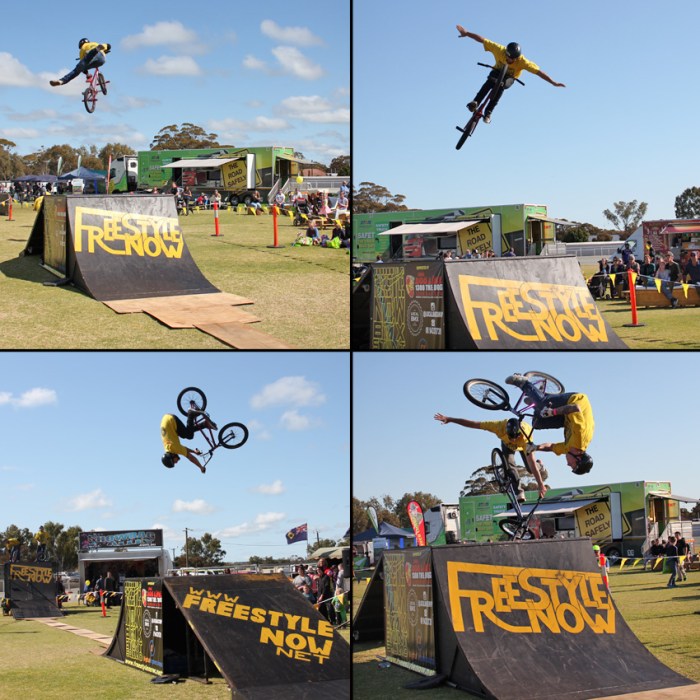
Freestyle BMX events bring an exhilarating mix of creativity and athleticism to the sports world, captivating audiences with jaw-dropping tricks and stunts. Riders showcase their skills across diverse categories like Street, Park, and Dirt, each offering unique challenges and thrills. The evolution of these events over the years reflects the growing popularity and innovation of the sport, turning it into a vibrant community that celebrates both individual flair and camaraderie.
With roots tracing back to the late 1970s, Freestyle BMX has transformed from simple backyard tricks to a professional sport with global competitions. As riders continue to push the boundaries of what’s possible on two wheels, the excitement surrounding these events has only intensified, drawing in fans and participants alike.
Overview of Freestyle BMX Events
Freestyle BMX is a dynamic and exhilarating sport that has carved a unique niche in the global sports community. It encompasses a variety of riding styles where athletes perform tricks and maneuvers on their BMX bicycles. The significance of Freestyle BMX lies not only in its technical skill but also in its cultural impact, showcasing creativity, athleticism, and community engagement.Freestyle BMX events are categorized into several distinct styles, each with its own set of challenges and characteristics.
The main categories include Street, Park, and Dirt, which offer different environments and skill sets for riders to demonstrate their abilities.
Categories of Freestyle BMX Events
Understanding the categories of Freestyle BMX is crucial for appreciating the sport’s diversity. Each category presents unique challenges and requires specific skills from the riders. Below are the primary categories of Freestyle BMX events:
- Street: This category focuses on urban environments, utilizing the natural city landscape as obstacles. Riders perform tricks on benches, rails, and ledges, showcasing their creativity and technical prowess. Street riding emphasizes the ability to navigate and transform everyday structures into a playground.
- Park: Park events take place in specially designed skate parks featuring ramps, bowls, and various obstacles. Riders are judged based on their style, difficulty, and execution of tricks. This category allows for a combination of aerial tricks and technical ground movements, offering a broad spectrum of creativity.
- Dirt: Dirt events involve riders performing tricks on a series of dirt jumps and ramps. The focus here is on the ability to launch off jumps and perform aerial tricks while maintaining control. Dirt riding requires a high level of bike handling skills and physical endurance, as riders often face multiple jumps in succession.
Evolution of Freestyle BMX Events
Freestyle BMX has undergone substantial evolution since its inception in the late 1970s. Initially a subculture among BMX enthusiasts, it has grown into a global phenomenon. The sport was first recognized for its tricks and stunts, rapidly gaining popularity through competitions.Over the years, Freestyle BMX events have seen the introduction of professional competitions, including the X Games and the Olympics.
These platforms not only elevate the sport’s profile but also provide riders with opportunities to showcase their talent on an international stage. The evolution is characterized by increased participation, advancements in bike technology, and a growing audience that appreciates the artistry and skill involved in BMX riding.
“Freestyle BMX is not just a sport; it’s an expression of individuality and creativity.”
Law and Issues in Freestyle BMX
Freestyle BMX events, while thrilling and entertaining, are also surrounded by a complex web of legal considerations. Understanding these laws is crucial for athletes, organizers, and participants to ensure a safe and enjoyable experience. Various regulations and best practices must be adhered to, not only for compliance with the law but also to promote safety and minimize risks during events.
Legal Considerations Impacting Freestyle BMX Events
Freestyle BMX events must operate within a framework of local, state, and federal laws. These include regulations concerning public liability, event permits, and land use. Organizers are tasked with obtaining the necessary permits to hold events in public spaces, which often involves adhering to specific local ordinances regarding noise, crowds, and safety measures. Failure to comply with these laws can result in fines or event cancellations.
Safety Regulations and Best Practices in Event Organization
Safety is paramount in organizing Freestyle BMX events. Proper safety regulations ensure that participants, spectators, and staff are protected from potential accidents. Below are some key safety practices to implement:
- Providing proper protective gear such as helmets, pads, and appropriate clothing for all participants.
- Ensuring the event location is free of hazardous obstacles and has adequate space for riding.
- Establishing clear emergency procedures, including access to medical assistance and first aid stations.
- Conducting pre-event inspections of the ramps and equipment to ensure they meet safety standards.
Each of these safety measures plays a critical role in reducing the likelihood of injuries and creating a positive environment for all involved.
Implications of Liability Waivers and Insurance
Liability waivers are essential tools for both athletes and event organizers in the Freestyle BMX scene. These waivers serve to protect organizers from legal claims arising from injuries that may occur during events. It is crucial that these waivers are clearly written, outlining the risks involved in BMX riding and ensuring that participants understand what they are signing up for.Additionally, insurance coverage is a vital component in safeguarding the event and its participants.
Organizers should secure comprehensive liability insurance that covers accidents and injuries that may occur. The implications of inadequate insurance can be significant, leading to financial loss and potential lawsuits, which could jeopardize future events.
“Proper risk management through waivers and insurance is not just a legal necessity; it’s a critical aspect of fostering a safe space for athletes to thrive.”
The combination of legal awareness, safety regulations, and proper insurance practices creates a robust framework that supports successful and enjoyable Freestyle BMX events.
Related Sports and Their Connection to Freestyle BMX

Freestyle BMX, known for its creativity and athleticism, shares strong connections with a variety of sports, both extreme and traditional. Understanding these relationships not only enhances appreciation for Freestyle BMX but also reveals how different skills and cultures intertwine across disciplines. The following sections will explore the similarities and influences between Freestyle BMX and other sports, showcasing the broader athletic community’s connections.
Comparison with Other Extreme Sports
Freestyle BMX stands alongside other extreme sports, such as skateboarding and snowboarding, sharing core principles of creativity, risk-taking, and individual expression. Each sport emphasizes personal style and innovation, leading to unique cultural identities.
- Skateboarding utilizes similar tricks and maneuvers, often incorporating ramps and rails akin to those found in BMX parks. The influence is evident in the trick progression and the collaborative culture these sports foster.
- Snowboarding shares a connection through its emphasis on aerial maneuvers and freestyle techniques, with athletes often drawing on BMX skills for tricks performed in halfpipes or terrain parks.
Both skateboarding and snowboarding have helped shape the Freestyle BMX scene, encouraging riders to push boundaries and develop new skills. This cross-pollination has facilitated a vibrant community where athletes often transition between these sports, amplifying the overall excitement and creativity inherent in extreme sports.
Influence of Team Sports on Freestyle BMX Culture
While Freestyle BMX is predominantly an individual sport, its roots in BMX racing imbue it with a unique team-oriented culture. BMX racing emphasizes speed and competition, fostering camaraderie among riders.
- Team dynamics in BMX racing often lead to the sharing of techniques and risk-taking within the Freestyle BMX community. Riders who compete in both formats bring the competitive edge and teamwork learned on the race track into the freestyle arena.
- Events often feature both racing and freestyle competitions, allowing athletes to engage with different aspects of BMX culture and broaden their skill sets.
This blending of cultures results in a supportive environment where innovations in freestyle riding can flourish, with racers often contributing to the freestyle scene through mentorship and collaboration.
Crossover Skills with Martial Arts and Strength Sports
Interestingly, Freestyle BMX incorporates various skills found in martial arts and strength sports, highlighting the physicality and discipline necessary for success in the sport.
- Riders often utilize lower body strength, core stability, and agility, similar to martial artists who rely on these fundamentals for balance and power in their moves. The two disciplines share a focus on control, precision, and fluid motion in executing tricks.
- Strength sports, such as gymnastics, also provide a foundation for Freestyle BMX riders. The strength and flexibility developed through gymnastics translate to better bike handling and enhanced aerial performance.
The shared elements between these disciplines emphasize the importance of overall fitness and skill development, showcasing how Freestyle BMX thrives at the intersection of various athletic pursuits. This diversity enriches the experience of riders, enabling them to learn from other sports and apply those lessons to their BMX endeavors.
Closing Summary

In conclusion, Freestyle BMX events not only highlight the incredible talent of athletes but also embody a culture of creativity and resilience. Whether you’re a participant or a spectator, the thrill of watching riders take to the air and defy gravity is unmatched. As the sport continues to evolve, it promises to deliver even more breathtaking moments and inspire future generations of BMX enthusiasts.
Question Bank
What are the main categories of Freestyle BMX events?
The main categories include Street, Park, and Dirt, each focusing on different styles and terrains for riders to showcase their skills.
How do Freestyle BMX events ensure rider safety?
Event organizers implement safety regulations, including helmet requirements, designated riding areas, and emergency medical services on-site.
Are there age restrictions for participants in Freestyle BMX events?
Most events have specific age categories to ensure fair competition, often allowing participants from young children to adults.
What equipment is necessary for competing in Freestyle BMX?
Riders typically need a BMX bike, a helmet, and protective gear such as pads for elbows and knees to compete safely in events.
How can someone get involved in Freestyle BMX events?
Interested individuals can start by joining local BMX clubs, participating in workshops, and attending events to connect with other riders and gain experience.





